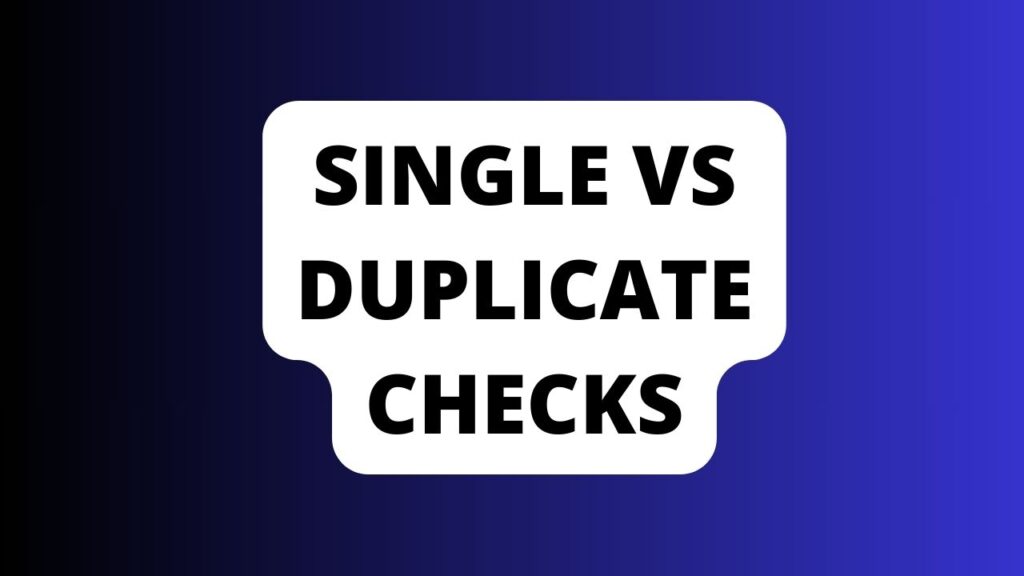Introduction
In the digital realm, ensuring data integrity remains paramount. As businesses rely heavily on information accuracy, single vs duplicate checks emerge as pivotal strategies. Understanding their nuances is crucial for safeguarding against errors and maintaining trust in information.
Defining Single Checks
Single checks refer to the process of verifying data through a singular validation source. This method involves scrutinizing information against a single reference point, emphasizing precision and accuracy in verification.
Defining Duplicate Checks
Conversely, duplicate checks involve validating data through multiple sources or redundant systems. The redundancy in cross-verification ensures error detection and reliability enhancement.
Importance of Verification
Verification acts as the cornerstone in data management, ensuring that the information accessed and utilized is accurate and dependable. Both single and duplicate checks serve this pivotal function, albeit through distinct approaches.
Understanding Single Checks
Benefits of Single Checks
The utilization of single checks offers a streamlined verification process, minimizing complexity while maximizing precision. This method ensures swift validation, ideal for immediate data needs.
Methods of Single Checks
Employing single checks involves various methodologies such as checksum validation, hash functions, and database queries. Each method caters to specific data types and verification requirements.
Importance of Accuracy
Single checks prioritize accuracy, making them invaluable for critical data where precision is non-negotiable. However, their reliance on a singular source poses challenges in diverse data environments.
Challenges in Single Checks
Despite their precision, single checks face challenges when encountering diverse data sources or when the reference source is compromised. Maintaining accuracy across varied data landscapes remains a persistent challenge.

Understanding Duplicate Checks
Benefits of Duplicate Checks
Duplicate checks excel in ensuring reliability by cross-verifying information across multiple sources. This redundancy minimizes the risk of errors, enhancing the overall integrity of data.
Methods of Duplicate Checks
Implementing duplicate checks involves synchronization across multiple databases, version control mechanisms, and cross-referencing strategies. This methodological diversity ensures comprehensive verification.
Importance of Redundancy
The redundancy inherent in duplicate checks minimizes the vulnerability to errors, offering a safety net against inaccuracies that might occur in individual sources. This redundancy enhances the dependability of information.
Challenges in Duplicate Checks
Despite their reliability, duplicate checks pose challenges in terms of resource utilization and synchronization complexities, especially in large-scale data operations.
Comparison: Single vs Duplicate Checks
Accuracy and Error Detection
Single checks excel in pinpoint accuracy, while duplicate checks prioritize error detection through redundancy, offering differing but equally critical approaches to data validation.
Resource Efficiency
Single checks demand fewer resources due to their singular validation source, whereas duplicate checks require more resources for cross-referencing and synchronization.
Versatility
Single checks suit immediate data needs with precision, while duplicate checks shine in ensuring reliability and error minimization, suitable for critical and diverse data landscapes.
Industry Applications
The application of these methods varies across industries; single checks find use in real-time data processes, while duplicate checks are prevalent in critical systems like finance and healthcare.
Best Practices
Implementing Single Checks
When implementing single checks, focus on the specificity of data needs, ensuring compatibility with the singular reference source and employing complementary validation methods.
Implementing Duplicate Checks
For duplicate checks, prioritize synchronization, maintain version control, and invest in robust cross-referencing mechanisms to ensure consistent and reliable verification.
Case Studies
Real-life examples showcasing the effectiveness of single and duplicate checks in different industries will illuminate the practical implementation and benefits of these verification methods.
FAQs
What are Single Checks?
Single checks involve data verification against a singular reference source for accuracy and precision.
What are Duplicate Checks?
Duplicate checks involve cross-verifying data through multiple sources or redundant systems to enhance reliability and error detection.
When to Use Single Checks?
Single checks are ideal for immediate data needs requiring pinpoint accuracy.
When to Use Duplicate Checks?
Duplicate checks are suited for critical systems and diverse data landscapes where reliability is paramount.
How Do Single Checks Enhance Security?
Single checks prioritize accuracy, ensuring secure data handling and minimizing errors in crucial information.
How Do Duplicate Checks Improve Reliability?
Duplicate checks minimize error vulnerability by cross-verifying data, enhancing overall data reliability and integrity.
Conclusion
In summary, understanding the nuances between single vs duplicate checks is pivotal for effective data management. While single checks emphasize precision, duplicate checks prioritize reliability, both playing indispensable roles in fortifying data integrity.
